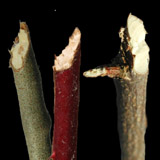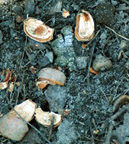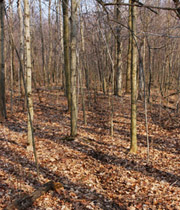Marks left by Chewing, Biting, Rubbing, or Walking
Most plants have signs of animals if you know what to look for and look closely. Many plants will have bite or chew marks. Others show rub marks. Another way to recognize that an animal has passed by is to look for trails.
Bite and Chew Marks
Sticks and tree branches can be covered with animal markings at times. Many different animals might peel the bark off of a dead log to get out the bugs that live inside it. During winter, bark itself can provide animals with a much needed food source. It is common to find chew marks on twigs and branches throughout the winter and in spring.
The chew marks that are most identifiable are those of rabbits and rodents. Those animals have enlarged front teeth, so their chew marks often show parallel grooves.
Rabbits and deer sometimes feed on the same plants. Twigs eaten by rabbits are usually cut sharply, at a 45 degree angle. Often the marks of individual teeth can be seen. (You might have to use a magnifying glass.)
Twigs eaten by deer are usually ripped off the bush or tree, and the torn edges are rough and irregular. The plants in the picture to the left have been gnawed on by deer.
It is also common to find the remains of nuts that have been chewed open by squirrels or other rodents.
Many leaves have bite marks from insects on them. Sometimes this makes the leaves look rough around the edges. Sometimes the leaves will be riddled with holes.
Many insects chew trails in wood beneath the bark. To find these kinds of tracks you can pull up the bark on a dead branch and see the maze of tunnels that have been made there.
Rubbings
Male deer rub their antlers on trees in late summer when they are shedding their antler velvet. This rubs the bark off the tree. If you see these rubbings, you know deer have been in the area.
Trails
Another way to recognize that an animal has passed by is to look for trails. Animals will wear down the paths that they choose, just like we do, so it is often easy to tell where they have been walking. Often you can find broken twigs that they passed by or walked on, or trees and rocks that they rubbed up against. Sometimes you can even find bits of hair that got caught on a twig as they passed.









